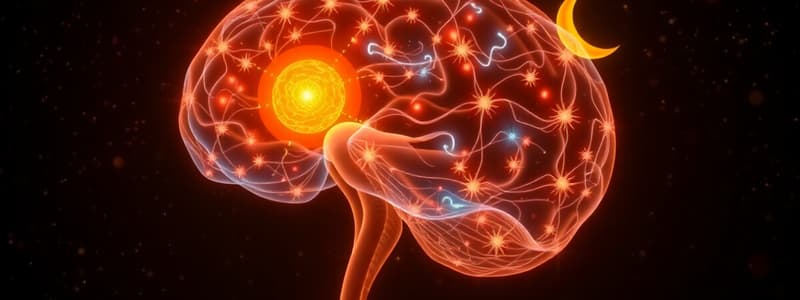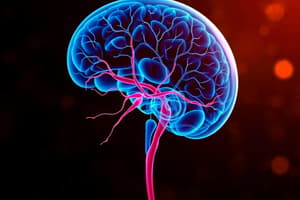Podcast
Questions and Answers
What is the primary role of pheromones in animals?
What is the primary role of pheromones in animals?
- To enhance the sense of smell in predators
- To trigger innate responses in other members of the species (correct)
- To act as a defense mechanism against intruders
- To provide food sources for other species
What cells are activated in the accessory olfactory epithelium?
What cells are activated in the accessory olfactory epithelium?
- Neuronal cells
- Basal and apical cells (correct)
- Epithelial cells
- Adipose cells
Where does the pathway from the basal cell in the vomeronasal system ultimately lead?
Where does the pathway from the basal cell in the vomeronasal system ultimately lead?
- Thalamus
- Amygdala (correct)
- Sensory cortex
- Hippocampus
Which part of the tongue is most concentrated with taste buds?
Which part of the tongue is most concentrated with taste buds?
What is the function of GPCR receptors in the olfactory process?
What is the function of GPCR receptors in the olfactory process?
Which of the following tastes is associated with the ability to taste glutamate?
Which of the following tastes is associated with the ability to taste glutamate?
What happens to the action potentials triggered by taste receptor cells?
What happens to the action potentials triggered by taste receptor cells?
Which type of taste bud is primarily located on the anterior part of the tongue?
Which type of taste bud is primarily located on the anterior part of the tongue?
What happens when NaCl binds to a salty receptor in a sweet cell?
What happens when NaCl binds to a salty receptor in a sweet cell?
Which brain wave is primarily associated with alertness and concentration?
Which brain wave is primarily associated with alertness and concentration?
During which sleep stage are hypnagogic hallucinations most commonly experienced?
During which sleep stage are hypnagogic hallucinations most commonly experienced?
Which of the following statements about non-REM sleep is false?
Which of the following statements about non-REM sleep is false?
Which stage of sleep often contains sleep spindles?
Which stage of sleep often contains sleep spindles?
What characterizes the theta waves observed in the N1 stage of sleep?
What characterizes the theta waves observed in the N1 stage of sleep?
Which brain wave pattern signifies deep sleep or coma?
Which brain wave pattern signifies deep sleep or coma?
What is the primary physiological response of a GPCR receptor when glucose binds to it?
What is the primary physiological response of a GPCR receptor when glucose binds to it?
What is the primary function of sleep spindles?
What is the primary function of sleep spindles?
Which stage of sleep is characterized by the presence of delta waves?
Which stage of sleep is characterized by the presence of delta waves?
What is one consequence of waking up during REM sleep?
What is one consequence of waking up during REM sleep?
Which of the following accurately describes circadian rhythms?
Which of the following accurately describes circadian rhythms?
What does Freud's theory suggest about dreams?
What does Freud's theory suggest about dreams?
What is a key function of K-complexes during sleep?
What is a key function of K-complexes during sleep?
What is the relationship between sleep and memory retention?
What is the relationship between sleep and memory retention?
What is one proposed purpose of dreaming according to evolutionary biology?
What is one proposed purpose of dreaming according to evolutionary biology?
What is a characteristic of Cheyne-Stokes breathing observed in polysomnography?
What is a characteristic of Cheyne-Stokes breathing observed in polysomnography?
What can chronic hyperventilation lead to in terms of heart health?
What can chronic hyperventilation lead to in terms of heart health?
Which theory suggests that hypnotism involves a divided consciousness?
Which theory suggests that hypnotism involves a divided consciousness?
What brain wave pattern is associated with deep meditation?
What brain wave pattern is associated with deep meditation?
Which type of drug is primarily used to reduce anxiety and induce sleep?
Which type of drug is primarily used to reduce anxiety and induce sleep?
Which neurotransmitter's activity is enhanced by benzodiazepines?
Which neurotransmitter's activity is enhanced by benzodiazepines?
What effect does alcohol have on REM sleep?
What effect does alcohol have on REM sleep?
What is a common side effect of using barbiturates?
What is a common side effect of using barbiturates?
What does the Activation Synthesis Hypothesis suggest about brain activity during sleep?
What does the Activation Synthesis Hypothesis suggest about brain activity during sleep?
What is a possible impact of sleep deprivation on individuals?
What is a possible impact of sleep deprivation on individuals?
What indicates a person may have sleep apnea?
What indicates a person may have sleep apnea?
What is the minimum amount of sleep recommended for adults?
What is the minimum amount of sleep recommended for adults?
How does narcolepsy primarily manifest in individuals?
How does narcolepsy primarily manifest in individuals?
What differentiates central sleep apnea from obstructive sleep apnea?
What differentiates central sleep apnea from obstructive sleep apnea?
What is one likely reason for the higher prevalence of sleepwalking in children?
What is one likely reason for the higher prevalence of sleepwalking in children?
Chronic use of sleep medications can lead to which of the following consequences?
Chronic use of sleep medications can lead to which of the following consequences?
What is the primary function of proprioception?
What is the primary function of proprioception?
Which type of receptor is primarily responsible for sensing temperature?
Which type of receptor is primarily responsible for sensing temperature?
What characterizes A-beta fibres in the context of pain sensation?
What characterizes A-beta fibres in the context of pain sensation?
How does the sense of smell contribute to the sense of taste?
How does the sense of smell contribute to the sense of taste?
What happens to the TrypV1 receptor when heat is applied?
What happens to the TrypV1 receptor when heat is applied?
What specific structure separates the olfactory epithelium from the brain?
What specific structure separates the olfactory epithelium from the brain?
What is the main reason people struggle to taste food when they have a cold?
What is the main reason people struggle to taste food when they have a cold?
Which type of receptor is NOT involved in nociception?
Which type of receptor is NOT involved in nociception?
Flashcards
Proprioception
Proprioception
The ability to sense the position and movement of your body in space. It involves specialized receptors in muscles and tendons that send information to the brain about body position, movement, and limb location.
Kinaesthesia
Kinaesthesia
The sense of movement and position of our body parts, particularly during motion. It's a more dynamic version of proprioception, focusing on the active perception of movement.
Nociception
Nociception
The ability to sense pain. This sense involves specialized receptors called nociceptors that detect harmful stimuli like injury, extreme temperatures, and chemicals.
Thermoception
Thermoception
Signup and view all the flashcards
TrypV1 Receptor
TrypV1 Receptor
Signup and view all the flashcards
Olfaction
Olfaction
Signup and view all the flashcards
Olfactory Epithelium
Olfactory Epithelium
Signup and view all the flashcards
Cribriform Plate
Cribriform Plate
Signup and view all the flashcards
Pheromone
Pheromone
Signup and view all the flashcards
Accessory Olfactory Epithelium
Accessory Olfactory Epithelium
Signup and view all the flashcards
Vomeronasal System
Vomeronasal System
Signup and view all the flashcards
Taste Bud
Taste Bud
Signup and view all the flashcards
Labelled Lines Model
Labelled Lines Model
Signup and view all the flashcards
Umami
Umami
Signup and view all the flashcards
Foliate Taste Bud
Foliate Taste Bud
Signup and view all the flashcards
Circumvallate Taste Bud
Circumvallate Taste Bud
Signup and view all the flashcards
Activation-Synthesis Hypothesis
Activation-Synthesis Hypothesis
Signup and view all the flashcards
Sleep Deprivation
Sleep Deprivation
Signup and view all the flashcards
Insomnia
Insomnia
Signup and view all the flashcards
Narcolepsy
Narcolepsy
Signup and view all the flashcards
Sleep Apnea
Sleep Apnea
Signup and view all the flashcards
N3 (Slow-Wave Sleep)
N3 (Slow-Wave Sleep)
Signup and view all the flashcards
Obstructive Sleep Apnea
Obstructive Sleep Apnea
Signup and view all the flashcards
Central Sleep Apnea
Central Sleep Apnea
Signup and view all the flashcards
G-protein coupled receptor (GPCR)
G-protein coupled receptor (GPCR)
Signup and view all the flashcards
Ligand
Ligand
Signup and view all the flashcards
G-protein
G-protein
Signup and view all the flashcards
Ion channel
Ion channel
Signup and view all the flashcards
Depolarization
Depolarization
Signup and view all the flashcards
Action potential (AP)
Action potential (AP)
Signup and view all the flashcards
Alertness
Alertness
Signup and view all the flashcards
Non-REM sleep (N3)
Non-REM sleep (N3)
Signup and view all the flashcards
K-complexes
K-complexes
Signup and view all the flashcards
N3 (Stage 3) sleep
N3 (Stage 3) sleep
Signup and view all the flashcards
REM sleep
REM sleep
Signup and view all the flashcards
Circadian Rhythms
Circadian Rhythms
Signup and view all the flashcards
Melatonin
Melatonin
Signup and view all the flashcards
Freud's Dream Theory
Freud's Dream Theory
Signup and view all the flashcards
Memory Consolidation
Memory Consolidation
Signup and view all the flashcards
Cheyne-Stokes Breathing
Cheyne-Stokes Breathing
Signup and view all the flashcards
Hypnosis
Hypnosis
Signup and view all the flashcards
Theories of Hypnosis
Theories of Hypnosis
Signup and view all the flashcards
Meditation
Meditation
Signup and view all the flashcards
Depressants
Depressants
Signup and view all the flashcards
Benzodiazepines
Benzodiazepines
Signup and view all the flashcards
Barbiturates
Barbiturates
Signup and view all the flashcards
Alcohol
Alcohol
Signup and view all the flashcards
Study Notes
Proprioception and Kinaesthesia
- Tiny sensors in muscles signal to spinal cord and brain, sensitive to muscle stretch.
- Sensors indicate muscle contraction/relaxation.
- Kinaesthesia, the awareness of body movement, is different from proprioception (body in space awareness), and doesn't include balance.
Pain and Temperature
- Nociception is pain, and thermoception is temperature.
- The TrypV1 receptor senses both heat and pain; heat causes conformational changes in the protein.
- Thousands of TrypV1 receptors are activated when a cell is damaged.
- Signal transmission involves 3 types of nerve fibres (fast, medium, slow).
- A-beta fibres (thick and myelinated) provide quick impulses, high conductance.
- A-delta fibres (thin and myelinated) convey pain signals.
- C fibres (thin and unmyelinated) transmit lingering pain sensations.
- Capsaicin, a chemical in spicy foods, triggers a similar response to pain in the TrypV1 receptor.
Taste and Smell
- Olfaction (smell) is when molecules travel up the back of the throat and into the back of the nose.
- Smell is important for taste.
- If your sense of smell is impaired, this affects taste perception.
Olfactory Epithelium
- Located in the nostril, it separates from the brain by the cribriform plate.
- Olfactory bulb projections pass through the plate to the epithelium.
- Receptors in the epithelium are sensitive to certain molecules (like benzene rings).
- Molecules bind to receptors, initiating a signal, which activates neurons.
- Olfactory neurons synapse with other cells in the olfactory bulb, forming glomeruli (clusters related to a molecule).
- The signal is then sent to the brain through mitral/tufted cells.
Pheromones
- Pheromones are chemical signals released by one animal that have an effect on another animal.
- Examples include mating and fighting
Gustation (Taste)
- Taste buds (fungiform, foliate, circumvallate) are concentrated on the tongue's anterior.
- Each taste bud has receptor cells, sensitive to different tastes (sweet, sour, salty, bitter, umami).
- Taste sensations are created through receptor activation and transmitted to the brain.
- A change in the receptors for taste and its effect on the brain could lead to a different brain interpretation as a different taste (e.g., salt receptor in a sweet receptor cell).
States of Consciousness
- Consciousness is how aware one is of themselves and their environment.
- States range from alertness, daydreaming, drowsiness, to different stages of sleep.
Sleep Stages
- Stages of sleep, N1, N2, and N3, have characteristic brainwaves (e.g., theta, delta).
- REM sleep (Rapid-eye movement) is a stage of deep sleep characterized by brain activity and vivid dreaming.
Circadian Rhythms
- Biological rhythms that operate on a 24-hour cycle, regulating body functions including sleep patterns, and controlled by melatonin.
- Daytime is often a factor for sleep-wake cycles, and artificial light can affect the cycle.
- Sleep needs vary by age, and older individuals usually require earlier sleep times.
Sleep Disorders
- Sleep deprivation can cause irritability, poor memory, and difficulty functioning.
- Sleep apnea involves abnormal breathing during sleep.
- Sleepwalking and sleep talking occurs during slow-wave sleep.
- Narcolepsy involves sudden, overwhelming feelings of sleepiness.
- Insomnia is recurring difficulty falling asleep or staying asleep.
Psychoactive Drugs
- Depressants, like alcohol, lower brain activity and lead to problems with function/memory.
- Barbiturates, benzodiazepines, are types of depressants.
Studying That Suits You
Use AI to generate personalized quizzes and flashcards to suit your learning preferences.



